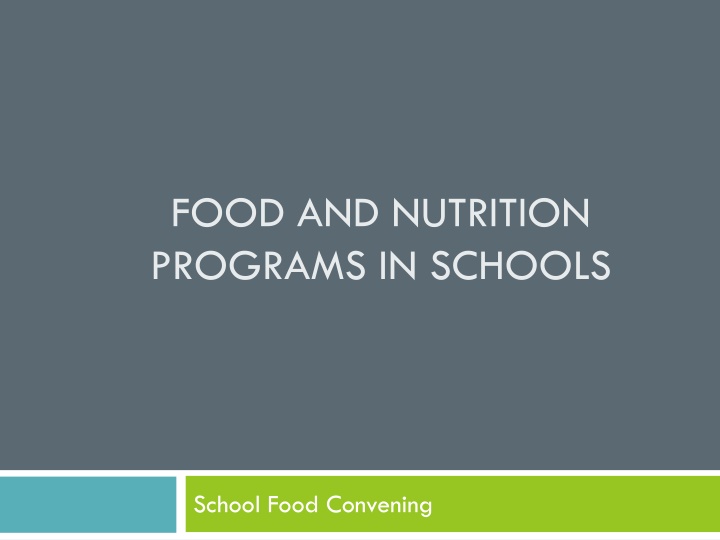
School Food Programs: Nourishing Children for Better Futures
Explore the impact of school food programs in California, serving 830 million meals yearly. Discover why school meals matter for children's nutrition, education, and well-being. Learn about the history of initiatives like the National School Lunch Program and the School Breakfast Program, aiming to provide free and affordable nutrition to students.
Download Presentation

Please find below an Image/Link to download the presentation.
The content on the website is provided AS IS for your information and personal use only. It may not be sold, licensed, or shared on other websites without obtaining consent from the author. If you encounter any issues during the download, it is possible that the publisher has removed the file from their server.
You are allowed to download the files provided on this website for personal or commercial use, subject to the condition that they are used lawfully. All files are the property of their respective owners.
The content on the website is provided AS IS for your information and personal use only. It may not be sold, licensed, or shared on other websites without obtaining consent from the author.
E N D
Presentation Transcript
FOOD AND NUTRITION PROGRAMS IN SCHOOLS School Food Convening
School meals are a big opportunity for positive change in California.
In California How big?
830 MILLION school meals served per year
4.4 MILLION school meals served on a typical day
Why do School Meals Matter? School meals provide the nutrition children need! Children who participate in the National School Lunch Program have superior nutritional intakes compared to those that do not participate Proper nutrition improves a child s behavior, school performance, and cognitive development Properly nourished children more actively participate in the education experience A healthy eating environment teaches children good nutrition and the elements of a proper diet, which can have positive effects on children s eating habits and physical well-being throughout life
23% of children live in poverty
2 MILLION children live in households that are food insecure
63% 68% 70% 59% students eligible for free and reduced price meals RIVERSIDE COUNTY SAN BERNARDINO COUNTY LOS ANGELES COUNTY
History of School Food Programs 1946 the National School Lunch Program (NSLP) 1966 the School Breakfast Program (SBP) was piloted and became a permanent program in 1975 Purpose: to provide free and affordable nutrition to children during the school day
History of School Food Programs The rise of early onset obesity and obesity- related issues in children has catalyzed calls for school food reform nationwide Movement has sprung up and there s a role for people in it! In Los Angeles the work began over 16 years ago. Since then school food has seen increasing and significant progress locally, at the state level and nationally
Healthy, Hunger Free Kids Act The Healthy, Hunger Free Kids Act passed by Congress in December 2010 Sought to improve the nutritional quality of school food Strengthened nutrition standards Significant increases in whole grains and fresh produce served in schools, Reductions in sodium and saturated fat Regulations of competitive food to make ALL food available to students healthier
How School Food Programs Work Federal government programs Congress United States Department of Agriculture (USDA) Department of Health and Human Services Administered by the state Operated by the districts Benefits are felt at the site level!
Funding for School Food Programs Congress sets funding levels USDA distributes federal funding to state agencies State government provides additional funds and distributes all reimbursement monies
Nutrition of School Food Programs School foods must meet meal pattern and nutrition standards based on the latest Dietary Guidelines for Americans. The current meal pattern increases the availability of fruits, vegetables, and whole grains in the school menu
Nutrition of School Food Programs The USDA requires that school food programs provide 5 components to ensure balanced nutrition Cafeterias must offer the following components Students must take at least 3 food components in order to have a reimbursable meal
Nutrition of School Food Programs Is this a complete, or reimbursable meal? Dairy Fruit Grain Protein Vegetables
School District Leadership What is the role of the Board of Education do in school food? Board members are elected to serve Board members set policy for the entire district, that includes school nutrition and adhering to USDA regulations in managing school food programs in cafeterias
District Leadership Board composition in Los Angeles Unified Michelle King Superintendent M nica Garc a George Mckenna Scott Steve Zimmer Schmerelson Refugio Rodr guez M nica Ratliff Richard Vladovic
Food Services Leadership Food Services runs school food programs according to federal, state and local regulations from budgets, to nutrition guidelines, promotes nutrition Ensures staff is trained in food preparation, costumer service, record keeping and all management related the operations of school cafeterias
School Leadership The principal ensures bell schedules allow for enough time to eat Ensures enforcement of competitive sales policies Leads the Wellness Policies efforts at the school site As heads of schools, Principals can set the tone for wellness in schools and be creative about including nutrition messages in all school activities
Cafeteria Leadership The Cafeteria Manager operates school nutrition programs in schools Ensures that meals are prepared according to standard and that every student takes a reimbursable meal
Teachers, Parents, other staff Adults can be role models and support healthy nutrition, especially in cafeterias Breakfast in the Classroom Connecting nutrition and food to topics in classroom Working with students and parents to ensure no ensure no outside foods are brought in for fundraisers
Resources Key Actors in School Food Policy and Programs, School Food Focus http://www.schoolfoodfocus.org/wp- content/uploads/2016/01/011116- FOCUSToolkitKeyActors.pdf Making the Case, Center for Ecoliteracy http://www.thecaseforschoolmeals.org Includes a two-minute video, a PowerPoint you can customize for your presentations, and a PDF packed with research data to help promote fresh, healthy school meals in your community.
Lets Stay in Touch Anna Colby anna@cfpa.net 213.482.8200 Elizabeth Medrano emedrano@oxy.edu 323.341.5097
